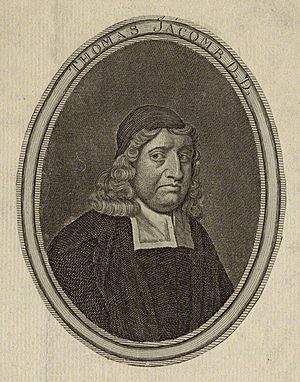Thomas Jacomb facts for kids
Thomas Jacomb (born in 1622, died in 1687) was an important English minister. He was one of many ministers who had to leave their churches in 1662. This event was known as the Great Ejection.
Contents
Thomas Jacomb's Early Life and Education
Thomas Jacomb was born in 1622 in Burton Lazars, a village near Melton Mowbray in Leicestershire. His younger brother, Samuel Jacomb, also became a well-known Puritan minister.
Thomas went to school in Melton and then studied for two years at Newark grammar school. He started his university studies at Magdalen Hall, Oxford, in 1640. When the First English Civil War began, he moved to St John's College, Cambridge, in 1642. He earned his first degree there in 1643. Soon after, he signed an important agreement called the Solemn League and Covenant. He then became a fellow (a senior member) at Trinity College, Cambridge.
Becoming a Minister
Jacomb finished his Master's degree in 1647. In the same year, he became a Presbyterian minister. He started working as a chaplain for the Countess-dowager of Exeter. He also became the minister at St. Martin's, Ludgate Hill in London.
The government also gave him important roles. He helped a group in London that decided if ministers and teachers were doing a good job. In 1659, he was chosen to be one of the "triers" of ministers. This meant he helped approve new ministers.
Life After the Restoration
Thomas Jacomb had moderate views, meaning he wasn't extreme in his beliefs. When the king returned to power in England (this was called the English Restoration) in 1660, Jacomb was given a special Doctor of Divinity (D.D.) degree from Cambridge University. Two other Presbyterian ministers, William Bates and Robert Wilde, also received this honor.
He was part of a royal group that reviewed the Book of Common Prayer in 1661. He was treated with respect during these meetings. Jacomb was on the Presbyterian side and helped write down their objections to the prayer book. Samuel Pepys, a famous diarist, heard him preach and enjoyed his sermons.
Ejection and Later Years
Despite his efforts, Thomas Jacomb was forced to leave his church in 1662 because he did not agree with the new rules. This was part of the Great Ejection.
After losing his church, Jacomb continued to preach in secret meetings called conventicles. He held these meetings in Silver Street, London. He was sometimes prosecuted (faced legal action) for this. However, his patroness, the Countess-dowager of Exeter, protected him. He even moved into her house in London in 1685.
Thomas Jacomb died there on March 27, 1687, at the age of 66. Many ministers, both those who followed the new rules and those who did not, attended his funeral. William Bates, another well-known minister, gave the sermon. Jacomb was known for his good life, his learning, and his serious nature.
Thomas Jacomb's Writings
Thomas Jacomb wrote several books and sermons during his life. These works often shared his religious views and teachings.
Some of his main works include:
- Enoch's Walk and Change (1656): This was a sermon he gave at a funeral.
- A Treatise of Holy Dedication (1668): This book was for London citizens moving into new homes after the Great Fire.
- Several Sermons, or Commentary preached on the whole 8th Chapter of Romans (1672): A collection of sermons about a chapter from the Bible.
- How Christians may learn in every way to be content (1674): This was a popular work about finding contentment.
Jacomb also signed a letter against the Quakers, a religious group. This led to a response from William Penn, a famous Quaker, in a pamphlet called A Just Rebuke. Jacomb's two farewell sermons, given just before he was ejected in 1662, were also published.


